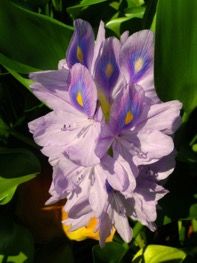
Credit: Willey Durden, USDA ARS
Host
waterhyacinth [Pontederia (formerly Eichhornia) crassipes (Mart.) Solms-Laubach (Pontederiaceae)]—for more information, see the EDIS publication Waterhyacinth: Florida's Worst Floating Weed at https://edis.ifas.ufl.edu/pdf/AG/AG38500.pdf.

Credit: Lyn Gettys, UF/IFAS
The genus Neochetina comprises six species whose native range is primarily South and Central America. All are semiaquatic, covered with a layer of very dense, water-repellent scales, and feed only on species of plants in the family Pontederiaceae.
Adults of N. bruchi and N. eichhorniae can usually be distinguished by the color and pattern of the scales covering the elytra (hardened protective wing cases). Neochetina bruchi ranges in color from uniform tan or brown with no distinct markings to brown with a broad, crescent-shaped or chevron-like tan band across the elytra, lending the species its common name "chevroned waterhyacinth weevil”. Neochetina eichhorniae, sometimes referred to as "mottled waterhyacinth weevil”, never has the tan band and is usually gray mottled with brown. The color pattern is associated with the scales and specimens may be difficult to identify if the scales are missing or the specimens are dirty or wet. Both species have two short, shiny, dark lines on the elytra on either side of the mid-line.
The eggs, larvae, and pupae of both species are very similar and virtually indistinguishable from one another. Identification of the immature stages is difficult. Eggs are whitish, ovoid, and about 0.75 mm in length. Because they are embedded in the plant tissue, they can usually only be found by carefully dissecting the plant. Pupae are white. The pupa is enclosed in a cocoon formed among the lateral rootlets and attached to the main root axis below the water surface. These appear as small balls or nodules about 5 mm in diameter on the roots and are usually near the stem.

Credit: USDA ARS
Eggs of both species of Neochetina are deposited directly in the plant tissue. The eggs hatch within 7 to 10 days at 75°F. The female weevils begin to lay eggs within a few days after emerging from the pupa and most are deposited within the first week. A single female N. bruchi will deposit up to 300 eggs and a female N. eichhorniae can deposit in excess of 400 eggs during her lifetime. About 90% of the eggs are deposited within a month after the female emerges, although the adults may live for more than 9 months. Larvae pass through a total of three larval instars. Third instars are generally located at the petiole bases and may enter the stem (rhizome) and excavate small pockets near the point of insertion of the leaf. Larvae occasionally burrow up the stem to enter the base of younger petioles and sometimes reach the stem apex and destroy the apical bud. The larval period requires 30 to 45 days, with N. bruchi developing somewhat faster than N. eichhorniae.
Both weevil species are widespread in Florida and can be found everywhere waterhyacinth grows. The adults chew characteristic round feeding marks on the leaves and petioles. Feeding by the weevils weakens plants and reduces flowering and subsequent seed production by up to 97% and biomass by up to 58% in the field. It is now possible to kill weevil-infested plants with lower rates and fewer applications of 2,4-D compared with un-infested plants that require higher rates and grow back much more rapidly following herbicide applications.

Credit: Philip Tipping, USDA ARS